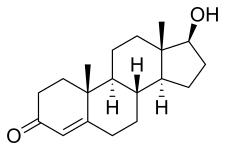
Back تستوستيرون (دواء) Arabic Testosterona (medicación) Spanish تستوسترون (دارو) Persian Testostérone (médicament) French Testosterone (farmaco) Italian Testosteron (medicatie) Dutch ଟେଷ୍ଟୋଷ୍ଟେରନ(ଔଷଧ) OR Testosterona (medicação) Portuguese เทสโทสเตอโรน (ยา) Thai Testosteron (ilaç) Turkish
 | |
 | |
| Clinical data | |
|---|---|
| Pronunciation | /tɛˈstɒstəroʊn/ teh-STOS-tə-rohn[1] |
| Trade names | AndroGel, Testim, TestoGel, others |
| Other names | Androst-4-en-17β-ol-3-one |
| AHFS/Drugs.com | Monograph |
| MedlinePlus | a619028 |
| License data |
|
| Pregnancy category |
|
| Dependence liability | Moderate [3] |
| Addiction liability | Moderate [3] |
| Routes of administration | buccal, intranasal, subcutaneous implant, transdermal (gel, cream, patch). |
| Drug class | Androgen, anabolic steroid |
| ATC code | |
| Legal status | |
| Legal status |
|
| Pharmacokinetic data | |
| Bioavailability | Oral: very low (due to extensive first pass metabolism) |
| Protein binding | 97.0–99.5% (to SHBG and albumin)[8] |
| Metabolism | Liver (mainly reduction and conjugation) |
| Elimination half-life | 2–4 hours[citation needed] |
| Excretion | Urine (90%), feces (6%) |
| Identifiers | |
| |
| CAS Number | |
| PubChem CID | |
| IUPHAR/BPS | |
| DrugBank | |
| ChemSpider | |
| UNII | |
| KEGG | |
| ChEBI | |
| ChEMBL | |
| Chemical and physical data | |
| Formula | C19H28O2 |
| Molar mass | 288.431 g·mol−1 |
| 3D model (JSmol) | |
| Specific rotation | +110.2° |
| Melting point | 155 °C (311 °F) |
| |
| |
| (verify) | |
Testosterone is a medication and naturally occurring steroid hormone.[9] It is used to treat male hypogonadism, gender dysphoria, and certain types of breast cancer.[9][10] It may also be used to increase athletic ability in the form of doping.[9] It is unclear if the use of testosterone for low levels due to aging is beneficial or harmful.[11] Testosterone can be administered through several different routes, including topical gels or patches, nasal sprays, subdermal implants, or tablets dissolved inside the mouth.[9]
Common side effects of testosterone include acne, swelling, and breast enlargement in men.[9] Serious side effects may include liver toxicity, heart disease, and behavioral changes.[9] Women and children who are exposed may develop masculinization.[9] It is recommended that individuals with prostate cancer should not use the medication.[9] It can cause harm to the baby if used during pregnancy or breastfeeding.[9] Testosterone is in the androgen family of medications.[9]
Testosterone was first isolated in 1935, and approved for medical use in 1939.[12][13] Rates of use have increased three times in the United States between 2001 and 2011.[14] It is on the World Health Organization's List of Essential Medicines.[15] It is available as a generic medication.[9] In 2022, it was the 118th most commonly prescribed medication in the United States, with more than 5 million prescriptions.[16][17]
- ^ Testosterone. Oxford Dictionaries.
- ^ "Testosterone Use During Pregnancy". Drugs.com. August 20, 2019. Archived from the original on February 1, 2014. Retrieved January 8, 2020.
- ^ a b "Anabolic steroid misuse". nhs.uk. November 4, 2022. Retrieved July 12, 2024.
- ^ "FDA-sourced list of all drugs with black box warnings (Use Download Full Results and View Query links.)". nctr-crs.fda.gov. FDA. Retrieved October 22, 2023.
- ^ Anvisa (March 31, 2023). "RDC Nº 784 - Listas de Substâncias Entorpecentes, Psicotrópicas, Precursoras e Outras sob Controle Especial" [Collegiate Board Resolution No. 784 - Lists of Narcotic, Psychotropic, Precursor, and Other Substances under Special Control] (in Brazilian Portuguese). Diário Oficial da União (published April 4, 2023). Archived from the original on August 3, 2023. Retrieved August 15, 2023.
- ^ Human Medicines Evaluation Division (September 1, 2022). "Active substance: testosterone (all formulations apart from topical use)" (PDF). List of nationally authorised medicinal products. European Medicines Agency. Archived (PDF) from the original on September 6, 2022. Retrieved September 6, 2022.
- ^ Human Medicines Evaluation Division (September 1, 2022). "Active substance: testosterone (topical use)" (PDF). List of nationally authorised medicinal products. European Medicines Agency. Archived (PDF) from the original on September 6, 2022. Retrieved September 6, 2022.
- ^ Melmed S, Polonsky KS, Larsen PR (November 11, 2015). Williams Textbook of Endocrinology. Elsevier Health Sciences. pp. 709, 711, 765. ISBN 978-0-323-34157-8. Archived from the original on April 14, 2019. Retrieved November 18, 2016.
- ^ a b c d e f g h i j k "Testosterone". Drugs.com. American Society of Health-System Pharmacists. December 4, 2015. Archived from the original on August 20, 2016. Retrieved September 3, 2016.
- ^ "List of Gender Dysphoria Medications (6 Compared)". Drugs.com. Archived from the original on April 26, 2020. Retrieved May 6, 2020.
- ^ Staff (March 3, 2015). "Testosterone Products: Drug Safety Communication – FDA Cautions About Using Testosterone Products for Low Testosterone Due to Aging; Requires Labeling Change to Inform of Possible Increased Risk of Heart Attack And Stroke". FDA. Archived from the original on March 5, 2015. Retrieved March 5, 2015.
- ^ Taylor WN (2002). Anabolic Steroids and the Athlete (2nd ed.). McFarland. p. 180. ISBN 978-0-7864-1128-3. Archived from the original on September 14, 2016.
- ^ Fischer J, Ganellin CR (2006). Analogue-based Drug Discovery. John Wiley & Sons. p. 481. ISBN 9783527607495. Archived from the original on August 23, 2022. Retrieved August 18, 2020.
- ^ Desroches B, Kohn TP, Welliver C, Pastuszak AW (April 2016). "Testosterone therapy in the new era of Food and Drug Administration oversight". Translational Andrology and Urology. 5 (2): 207–12. doi:10.21037/tau.2016.03.13. PMC 4837303. PMID 27141448.
- ^ World Health Organization (2019). World Health Organization model list of essential medicines: 21st list 2019. Geneva: World Health Organization. hdl:10665/325771. WHO/MVP/EMP/IAU/2019.06. License: CC BY-NC-SA 3.0 IGO.
- ^ "The Top 300 of 2022". ClinCalc. Archived from the original on August 30, 2024. Retrieved August 30, 2024.
- ^ "Testosterone Drug Usage Statistics, United States, 2013 - 2022". ClinCalc. Retrieved August 30, 2024.